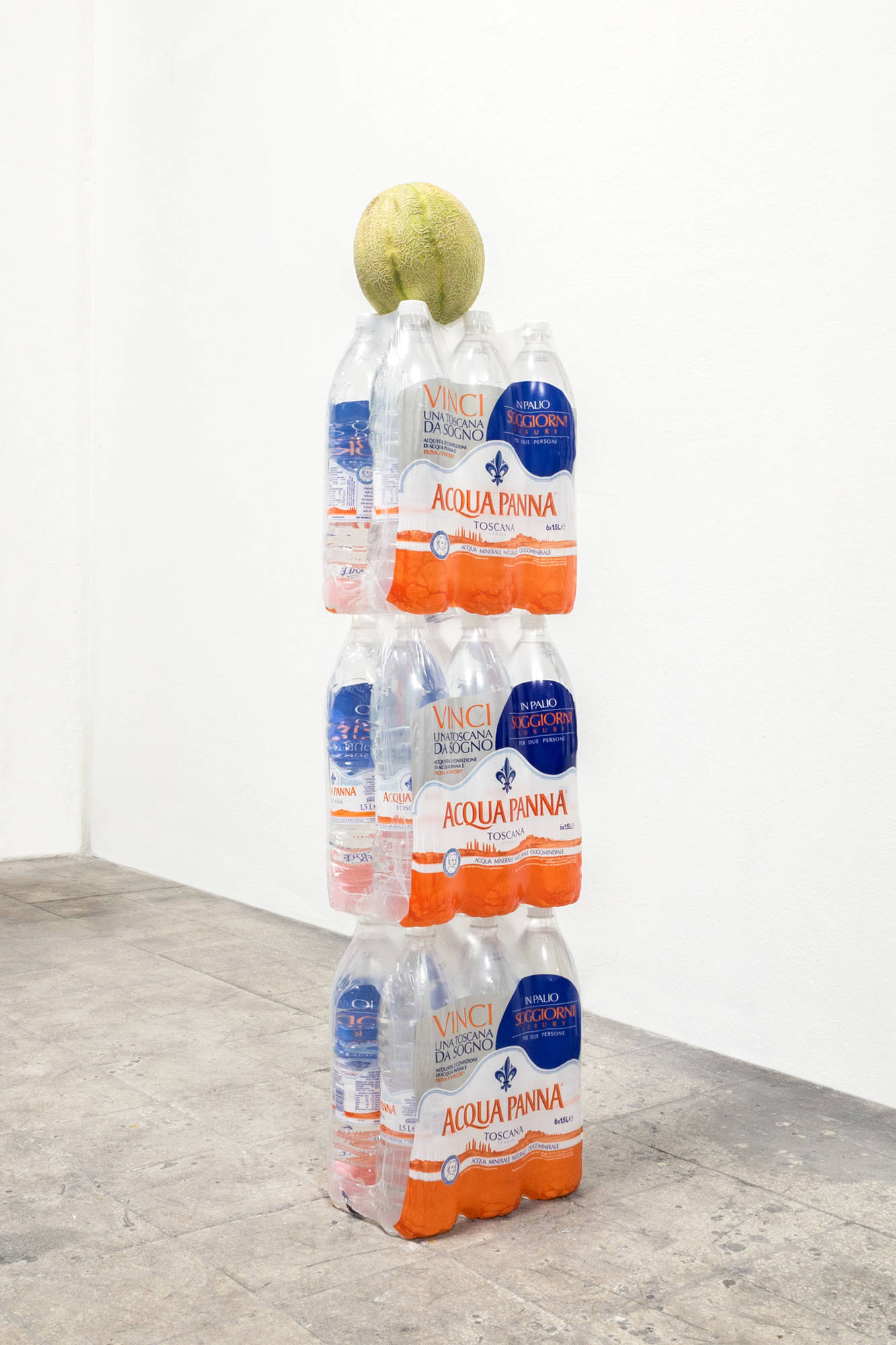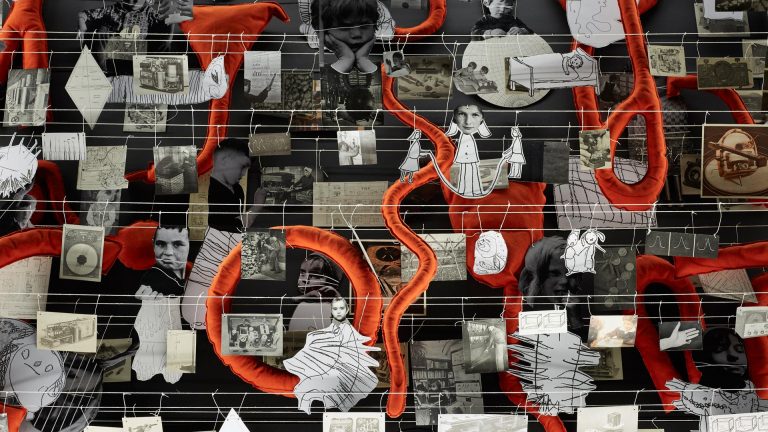Artist: Gabriele De Santis
Exhibition title: I Can Skip The Turtles This Time
Venue: ULTRASTUDIO, Pescara, Italy, Los Angeles, US
Date: June 24 – September 8, 2018
Photography: all images copyright and courtesy of the artist and ULTRASTUDIO
In 2018. Between the self and the self there is always the other
A. We are in 2018. SWe are still far from 16 December 16, 2040, our hundredth birthday, yet we are but yet we are getting closer to the 11th July 11, 2023, the date of our alleged death.
B. We are in 2018! We can write our 14th telegram for the Serie di merli disposti ad intervalli regolari lungo gli spalti di una muraglia. If we sent it today we would write 16.700 days ago it was 2 May 2, 1971, which means. It is also 400.800 hours ago, 1.422.880.000 seconds ago.
A. Do you remember in Alice’s Adventures in WonderlandLe avventure di Alice nel paese delle Meraviglie, by Lewis Carroll, when Alice, drinking tea in the company of the Mad Hatter, noticed histhe clockk of Cappellaio? ‘What a funny watch!’ she remarked. `It tells the day of the month, and doesn’t tell what o’clock it is!’ ‘Why should it?’ muttered the Hatter. `Does your watch tell you what year it is?’ `Of course not,’ Alice replied very readily: `but that’s because it stays the same year for such a long time.’
B. Ours watchesclock are instead annual clocks where the clock face displays – rather than the hours’ digitscyphers like 12, 3, 6, 9 – the ones of the currentprevious year, suspendinglaying off the conventional time telling of the wristwatch. It’s impossible to measure what seems to flow. So As long as we don’t mess with it – something that happens quite often – time can make the clocks do everything it likes (1)
A. Also the calendar, where years and days can switch. From 365/366 days, it’s enough to select a few to compose a collage, the cipher of the year. It’s no longer a linear or mathematical time, but an existential time. It’s a replaced, condensed, re-combined time, where temporal measures of different orders trade places, where time can be played.
A. Same for the calendar, where years and days can swap places. Of the 365/366 days available on a calendar, it’s enough to select a few of them to compose a collage with the figure of the year. It’s no longer a linear or mathematical time, but an existential one. A replaced, condensed, re-combined time, where temporal measures of different orders exchange places, where time can be played with.
B. Do they also ask you continuously ask you why dates are so important for us?
A. … And the answer is always the same: DThe dates? DoO you know why they are very important? Because if, for instance, you write on a wall ‘1970’ it might seems nothing important, but in thirty years…. With every day which goes by, this date becomes more beautiful, it’s time at work. Dates indeed have this beauty, the more time passes by, the more beautiful they become. (2)
B. Today 1970 is the time – and space – of mythological nostalgia. Us, well weWe ourselves took the appearance of an eccentric figure, to a certain extent suspended in a legendary limen. The language through which we communicated at the time is known today familiar, historicized, almost well-established. Yet for us it continues to beis always an experiment, a game. Niente da vedere, niente da nascondere (Nothing to see, nothing to hide) we declared in 1969 via our work. A frame which leads towards the outside.
A. We are in 2017. If we were to write 2018 on a wall now, what will everybody think in thirty years? What will be left of its symbols and aesthetic? The filter of time we explore needs to challenge the spectator to go beyond trespass the retinal sphere, to define the seeing experience in a new way.
B. Do we want to see or hide today? Or better: is it possible to see or is it preferable to hide in a safer elsewhere? It’s important to face the present, to not fear it, or seek refuge in the past or in a incessant appropriation, citationism, but to welcome that which has been into an unpredictable scheme, in order to, before everything elseabove all, build an iconography of the current time.
A. And after all moreover how can we predict the present? In its confrontationrossing with the past, or in its future crossingscrossings, as how are we are doing now? The nonsenses, the inversions, the clocks, the calendars, the harebrained odd telegrams, the allusions to the (dis)measures of time, the possible meetings encounters and those we desire to have, can be highlighted and elaborated in order to write a page on our timeoday.
B. I don’t have an answer but a proposal. First of all, to be involved in the present, to know how to face it, interpret it, and put it into a shapetranslate it, and shape it. This is what we intend to do. To play with the image and make the game participate, to create a short circuit of and into ordinary experience, are all variablesoptions that shouldn mustn’t be underestimated.
A. Yes, to disclose art to the dimension of time, to lose the gaze, to involve the spectator and draw him into the invented and built-up dimension. Perhaps we need to act as prophets psychics. DALL’OGGI AL DOMANI (FROM TODAY TO TOMORROW)OVERNIGHT. Without any prophecy art is incomplete. A prophecy that can involve give enclosure, that can draw, that brings the observer to strive to see the invisible.
B. We are in 2018. So let’s keep meditating on time, this intangible concept. Let’s not isolate it, let’s not crystallise it into a microcosm. Let’s unfold it toward its infinite possible images. Here we are: DARE TEMPO AL TEMPO (JUST GIVE IT SOME TIME TO TIME) in that POZZO SENZA FINE (BOTTOMLESS HOLE). If we can manage to be vedenti (to be those who see)seeing, time it will reveal itself.
Notes
(1)La voce “tempo” in Giacinto Di Pietrantonio (a cura di), Alighiero Boetti. Quasi Tutto, SilvanaEditoriale, 2004.
(2)Intervista con Mirella Bandini, 1972, in Alighiero Boetti (1965-1994), Mazzotta 1996.
Ilaria Gianni























